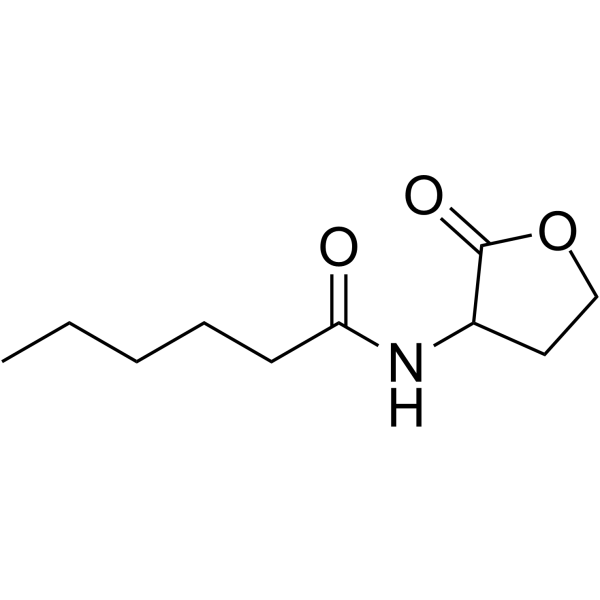N-Hexanoyl-DL-homoserine lactone

N-Hexanoyl-DL-homoserine lactone structure
|
Common Name | N-Hexanoyl-DL-homoserine lactone | ||
|---|---|---|---|---|
| CAS Number | 106983-28-2 | Molecular Weight | 199.24700 | |
| Density | N/A | Boiling Point | N/A | |
| Molecular Formula | C10H17NO3 | Melting Point | 101-106 °C | |
| MSDS | USA | Flash Point | N/A | |
Use of N-Hexanoyl-DL-homoserine lactoneN-Hexanoyl-DL-homoserine lactone is a bacterial quorum sensing molecule produced in the rhizosphere. N-Hexanoyl-DL-homoserine lactone, a bacterial quorum sensing signal, induces transcriptional changes in Arabidopsis and may contribute to tuning plant growth to the microbial composition of the rhizosphere[1]. |
| Name | N-(2-Oxotetrahydro-3-furanyl)hexanamide |
|---|---|
| Synonym | More Synonyms |
| Description | N-Hexanoyl-DL-homoserine lactone is a bacterial quorum sensing molecule produced in the rhizosphere. N-Hexanoyl-DL-homoserine lactone, a bacterial quorum sensing signal, induces transcriptional changes in Arabidopsis and may contribute to tuning plant growth to the microbial composition of the rhizosphere[1]. |
|---|---|
| Related Catalog | |
| References |
| Melting Point | 101-106 °C |
|---|---|
| Molecular Formula | C10H17NO3 |
| Molecular Weight | 199.24700 |
| Exact Mass | 199.12100 |
| PSA | 58.89000 |
| LogP | 1.83870 |
| Storage condition | 2-8°C |
| Personal Protective Equipment | Eyeshields;Gloves;type N95 (US);type P1 (EN143) respirator filter |
|---|---|
| Safety Phrases | 24/25 |
| RIDADR | NONH for all modes of transport |
| WGK Germany | 3 |
| HS Code | 2932209090 |
| HS Code | 2932209090 |
|---|---|
| Summary | 2932209090. other lactones. VAT:17.0%. Tax rebate rate:13.0%. . MFN tariff:6.5%. General tariff:20.0% |
|
Quorum sensing and Chromobacterium violaceum: exploitation of violacein production and inhibition for the detection of N-acylhomoserine lactones.
Microbiology 143 , 3703, (1997) Quorum sensing relies upon the interaction of a diffusible signal molecule with a transcriptional activator protein to couple gene expression with cell population density. In Gram-negative bacteria, s... |
|
|
Detection of acyl-homoserine lactones by Escherichia and Salmonella.
Curr. Opin. Microbiol. 14 , 188-193, (2011) Escherichia and Salmonella do not synthesize quorum-sensing signaling molecules of the N-acyl-l-homoserine lactone (AHL) type but they can detect AHLs produced by other species of bacteria. AHLs are p... |
|
|
N-acyl homoserinelactone-mediated gene regulation in gram-negative bacteria.
Syst. Appl. Microbiol. 22 , 493-506, (1999) The view of bacteria as unicellular organisms has strong roots in the tradition of culturing bacteria in liquid media. However, in nature microbial activity is mainly associated with surfaces where ba... |
| N-Hexanoyl-DL-homoserine lactone |
| N-Caproyl-DL-homoserine lactone |
| 1-hexanoyl-azepan-2-one |
| 3-hexanoylamino-dihydro-furan-2-one |
| 2H-Azepin-2-one,hexahydro-1-(1-oxohexyl) |
| hexanoyl-homoserine lactone |
| (+/-)-N-hexanoyl-homoserine lactone |